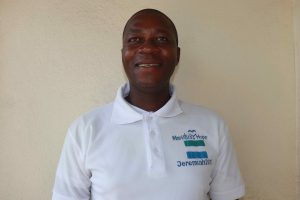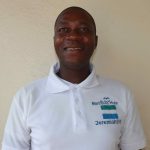The 418 students, staff, and community members who rely on the Kathoma COG Primary School well struggle to have sufficient water. This forces students to search for water off school grounds, interrupting their education and ultimately negatively affecting their futures.
The water crisis has led to hostility in the community, which is very disruptive to school lessons. Field Officer Moses Gbassay Kebbie said, "The school water source is often overcrowded, especially in the dry season (April to May), when there is a shortage of water within the community. This could lead to quarreling, stealing of property, and physical abuse. The main water source leads to long waits because of the crowd. Due to fighting among the water users, they might damage the pump machine or their water fetching containers."
However, hostility in the community isn't the only problem. Teacher Sheku Bangura, 58 (seen below), shared, "As a teacher, I need water to do practical work with the pupils, which is part of the teaching subjects. We find it difficult to do the practical work when there is a water crisis. We sometimes spend the rest of the day without doing the practical aspects, which may delay the learning process of the pupils."

"In addition, the teacher and pupils are faced with water challenges even more in using the sanitation facility (shown below) in the school environment. The entire school population must use the sanitation facility at least two times daily during their day at school, and there is not enough water at the school to prevent the sanitation facility from getting dirty with an unpleasant smell. They might contract diseases like cholera or diarrhea," he continued.

Clean, easily accessible water is crucial for children to have the education needed to make a lasting impact on their futures. Alas, at Kathoma COG Primary School, if students cannot use their well, they are forced to use an unprotected protected dug well in the community, which presents its own challenges.
10-year-old Ramatu K., shown below at the unprotected dug well, expressed her concerns about the water crisis at her school. "I am in dire need of water to work on my practical work in class. I am unable to do the practical aspects if there is a continuous shortage of water, and this prevents me from understanding the importance of the practical aspects. When there is a breakdown of the main water source, we fetch water from the alternate source that is not pure to drink, and sometimes, I become ill from drinking this water. I might have stomach pain or diarrhea to the extent that I must go to the hospital to regain my health. We are exposed to disease outbreaks because of using water from this source."

"Sometimes, when there is a challenge of water, I spend so much time at the alternate source that I miss the whole school day. I need water after using the restroom to clean my hands. This may be difficult for me if there is insufficient water. We sometimes use leaves to clean ourselves, which is a bad hygiene practice. With this, we are exposed to diseases like diarrhea and cholera [again]," she continued.
"The water challenges in school and at home are affecting me seriously. If not solved, [it] will lead to negative affects on my life and the community. The shortage of water deprives me of going to school on time. I sometimes go to school late, and this affects my academic performance," Ramatu concluded.
Rehabilitating the well on the Kathoma COG Primary School grounds will give the teachers and students the opportunity to invest in their futures. The students and staff are passionate and, with the right tools, could have the opportunity to flourish, but the first step is to give them access to clean, accessible water. Once they have a safe and reliable water source, they can commit to their practical lessons and dream of a brighter tomorrow for the whole community.
The Proposed Solution, Determined Together...
At The Water Project, everyone has a part in conversations and solutions. We operate in transparency, believing it benefits everyone. We expect reliability from one another as well as our water solutions. Everyone involved makes this possible through hard work and dedication.
In a joint discovery process, community members determine their most advantageous water solution alongside our technical experts. Read more specifics about this solution on the What We're Building tab of this project page. Then, community members lend their support by collecting needed construction materials (sometimes for months ahead of time!), providing labor alongside our artisans, sheltering and feeding the builders, and supplying additional resources.
Water Access for Everyone
This water project is one piece in a large puzzle. In Kenya, Sierra Leone, and Uganda, we're working toward complete coverage of reliable, maintained water sources that guarantee public access now and in the future within a 30-minute round trip for each community, household, school, and health center. One day, we hope to report that this has been achieved!
Training on Health, Hygiene & More
With the community's input, we've identified topics where training will increase positive health outcomes at personal, household, and community levels. We'll coordinate with them to find the best training date. Some examples of what we train communities on are:
- Improved hygiene, health, and sanitation habits
- Safe water handling, storage & treatment
- Disease prevention and proper handwashing
- Income-generation
- Community leadership, governance, & election of a water committee
- Operation and maintenance of the water point

 Borehole Well and Hand Pump
Borehole Well and Hand Pump




























